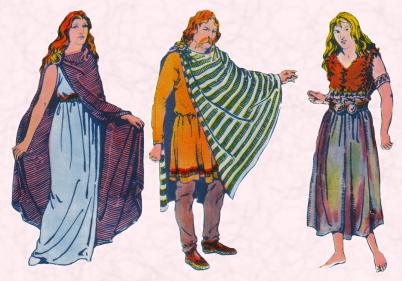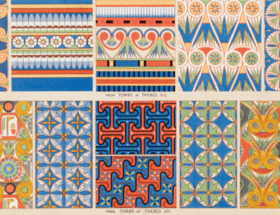By Pauline Weston Thomas for Fashion-Era.com

- Early Clothing History
- Weaving and Use of Skins
- The Use of a Bone Needle
- Early Necklaces
- Early Fabrics
- Spinning & Carding Wool
- Biblical Comments on Cloth
- Proverbs, Chapter 31, Verses 10-28
- Northern European Dress 1600 BC
- Celtic Dress About 600 BC to 100 AD
Weaving and Use of Skins
No one can be absolutely certain that early man wore clothing as we know it. But researchers in the late C20th, found evidence of fine weaving in the Czech region.
This was observed from studying illustrated archaeological pottery artefacts from the region.
Clearly cold or hot climatic conditions were probably the first reason for man to clothe himself and his family.
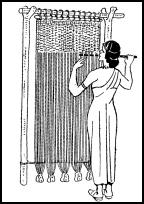
The condition of extreme cold or excess heat means that the human race uses materials for skin protection. Those living in warmer geographical regions need less clothing, but some skin covering is almost always necessary as protection from the extreme heat of the sun and the resultant sun burn.
Other reasons for wearing clothing, such as rank, decoration, occupational trade, tribal and group affiliation are discussed in the meaning of fashion.
Above left - Egyptian woman weaving cloth using a basic upright loom and simple method where a yarn is placed over and under a warp thread, the threads that hang down which are weighted with stones.
It is now known that weaving was carried out as far back as 27,000 years ago. This fact was discovered only at the turn of this millennium. Until then it was thought weaving was only a skill only first used about 10,000 years ago. But now it is known that woven products were made to be used in body clothing and articles such as hats.
The very earliest of humans must have slung the skins of dead animals over their shoulders to keep warm or to lie on.
We know they sewed primitive shifts that covered the torso.
They used skins of animals - the fur and leather remnants obtained from animals caught for foodstuffs.
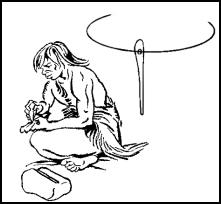
The very earliest of humans must have slung the skins of dead animals over their shoulders to keep warm or to lie on. We know they sewed primitive shifts that covered the torso. They used skins of animals - the fur and leather remnants obtained from animals caught for foodstuffs.
This page is an original early clothing Costume History article by Pauline Weston Thomas 2008 © - Copyright www.fashion-era.com
The Use of a Bone Needle
In the Old Stone Age men and women began to make clothes using needles made of bone. Flint knives were used to cut away splinters from bones. Once the bone splinter was rubbed smooth a hole was pierced in the thicker end and the point was sharpened.
Right - Early needle making - sharpening a splinter from a bone into a needle shaped tool which could be used to stitch together skins.
Bones were also used to make decorative necklaces, like this necklace shown below. Early jewellery was mostly made from found objects - seeds, stones and bones.
Early Necklaces
Necklaces were made from rubbed smooth bones, sea shells, teeth, fish bones, seeds or leather strips. 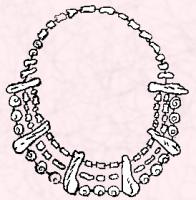
These necklaces were early status symbols, acted as talismans and prized as personal keepsake treasures.
Early Fabrics
These early Stone Age people also began to make pottery. They learnt how to polish hard stone so they could make a superior axe which helped them to cut wood and make boats. Other simple tools were those used for spinning and weaving.
Clothes were made by crudely spinning the fibres into yarns and weaving the yarns into rough fabrics similar to potato sacking. With expertise and finer and finer yarns, fabrics became finer and more luxurious.
Initially womenfolk probably collected tufts of sheep wool caught on bushes before realising that the fibres could just be taken off the sheep. Folk had used the sheep skins for warmth so using the hair of the sheep without the skin enabled them to control the weight of clothes.
In colder places like Chaldea (now Iraq) winter nights were cold, so warm hairy woollen cloth was an important alternative to the thinner fabrics such as linen and required for the hot summers.
Spinning & Carding Wool
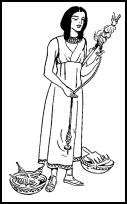
The wool was washed and then combed by carding it with thistles/teasel heads. When carded all the wool hairs lay in the same direction and that made the fibres easier to spin together.
The term carded comes from the Latin name for thistles and the word CARDUUS.
The carded wool was loosely tied on the distaff stick.
Whilst carrying the distaff under one arm, the spinner twisted a thread with the other hand. Once a small amount of twisted thread had been made the spinner attached it to the spindle and as spinning progressed a yarn ball developed which was kept compact and as continuous in length as practical.
The spindle had a round weight on the end called a spindle whorl and early spindle whorls were just a stone. In the illustration you see a basket of spun thread on spindle whorls.
The woman shown spinning, above left, is holding a spindle which has a weighted whorl, and under her arm she has a distaff covered with wool fibres. This is still the most eco-friendly way to make woollen yarn and uses only human energy! Once skilled, a spinner produces regular yarn with odd slubs. An unskilled spinner creates very nubby textured irregular yarns perfect for rustic craftwork!
People also experimented with materials like long grasses and large leaves to create coarse materials or fringes of grasses. Natural plant material like flax for example has to be treated by rotting to separate the 'bast' fibres which after various beating and combing procedures can be spun into linen yarns.
This page is an original early clothing Costume History article by Pauline Weston Thomas 2008 © - Copyright www.fashion-era.com
Biblical Comments on Cloth
 Ancient Egyptian dress
Ancient Egyptian dress
Flax was an important plant of the middle east and especially of Egypt.
The Name for linen in Latin is LINUM. The Flax plant also yielded valuable oil called linseed oil and of course strong linen thread.
The importance of a woman knowing how to make yarn, cloth and construct basic garments within the family was so important and high class a skill that verses in the Bible were devoted to the proficiency. This ability to create cloth made a woman an asset to the household.
Proverbs, Chapter 31, Verses 10-28
"Who can find a virtuous woman? For her prices is above rubies. She seeketh wool and flax, and worketh willingly with her hands, she layeth her hands to the spindle, and her hands hold the distaff. She stretcheth out her hand to the poor; yea, she reacheth forth her hands to the needy.
She is not afraid of the snow for her household; for all her household are clothed in scarlet. She maketh herself coverings of tapestry; her clothing is silk and purple. She maketh fine linen and selleth it; and delivereth girdles unto the merchant.
She looketh well to the ways of her household, and eateth not the bread of idleness. Her children arise up and call her blessed; her husband also, he praiseth her."
Northern Europe Dress 1600BC.
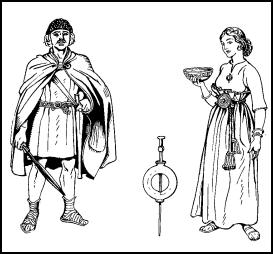
In northern European countries, people buried in the Scandinavian regions were sometimes preserved in their grave resting place by the acid peat nature of the soil.
The museums of Stockholm, Oslo and Copenhagen all have clothing which is pre-1600 BC.
Such clothing artefacts were made from a mixture of deer hair and wool fibres which created a very thick warm cloth, often dyed yellow, green or brown. Women wore a short top jacket and a soft pleated kilt like skirt held in position with a leather belt or wool rope girdle with tassels.
Left North European Costume about 3400 years ago. The decorative brooch/pin - centre - might be used as a clasp to hold garment pieces firmly together.
Note:- The girdle belt the woman wears is not the same as the corset type control panty girdle worn today.
Celtic Costume About 600 BC to 100 AD
From left to right this is the dress of a Celtic chief, in war dress, a Celtic chief in everyday civil clothing, and a Celtic chieftainess dressed for war.
Above from the left we have a Celtic woman; in the centre a Celtic man and on the far right a Celtic peasant.
A Celtic man and woman would have dressed in a very similar manner, but with a longer tunic and without weapons and protective arm bangles.
In fact everyday Celtic dress is most similar to Grecian clothing, but the fabrics the Celts used were coloured, coarser and heavier.
Vegetable dyes from plants and berries were used to create colours.
In this era other important clothing styles were those of the Egyptians, the Greeks and the Romans. You can read more on the linked pages.

This page is an original early clothing Costume History article by Pauline Weston Thomas 2008 © - Copyright www.fashion-era.com
Greek Dress
For women Greek dress consisted of the chiton which was artfully arranged in folds and tied with a girdle to keep the resulting gown style in place.
See more images of Greek hairstyles. Read about and see pictures of male Greek battle dress and Grecian helmets.
The Roman Toga
Britain was invaded by Julius Caesar in 55 and 54 BC. One hundred years later Britain became part of the Roman Empire. Then for some 400 years after that many Britons wore Roman styled dress.
After the fall of the Roman Empire Britain went into the period known as the Dark Ages and the next area of costume is of the Saxon and Frankish fashion era 500 to 599 AD and then of the Anglo Saxon era 600 AD to 1066.
Page added 14 October 2008 Ref: P.699.
